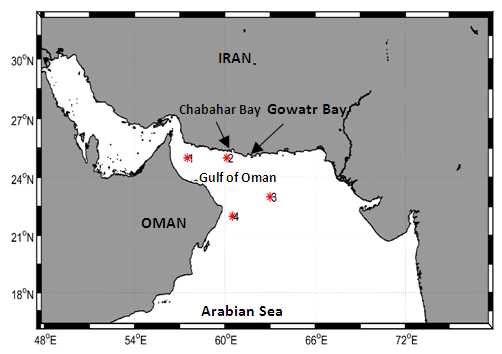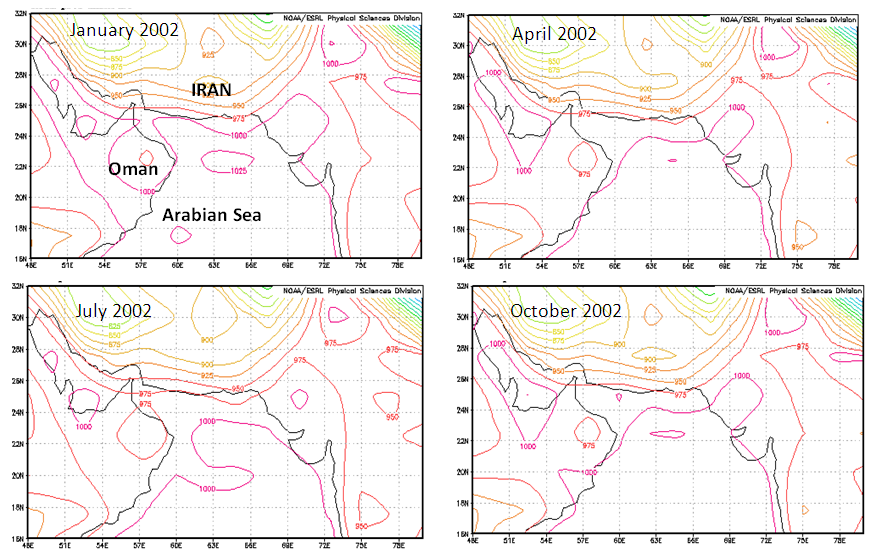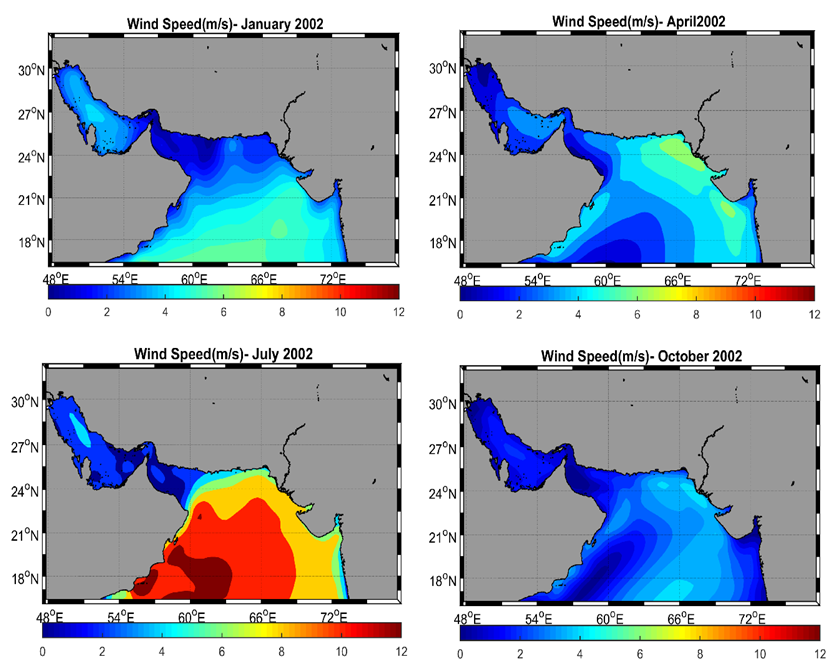-
Paper Information
- Next Paper
- Previous Paper
- Paper Submission
-
Journal Information
- About This Journal
- Editorial Board
- Current Issue
- Archive
- Author Guidelines
- Contact Us
American Journal of Fluid Dynamics
p-ISSN: 2168-4707 e-ISSN: 2168-4715
2018; 8(1): 1-9
doi:10.5923/j.ajfd.20180801.01

Overview of Wind Climatology for the Gulf of Oman and the Northern Arabian Sea
Nazanin Chaichitehrani1, Mohammad Nabi Allahdadi2
1College of the Coasts and Environment, Louisiana State University, Baton Rouge, LA, USA
2Department of Marine, Earth and Atmospheric Sciences, North Carolina State University, Raleigh, NC, USA
Correspondence to: Mohammad Nabi Allahdadi, Department of Marine, Earth and Atmospheric Sciences, North Carolina State University, Raleigh, NC, USA.
| Email: |  |
Copyright © 2018 Scientific & Academic Publishing. All Rights Reserved.
This work is licensed under the Creative Commons Attribution International License (CC BY).
http://creativecommons.org/licenses/by/4.0/

Wind data from three different Atmospheric models, including National Center for Environmental Prediction (NCEP), Climate Forecast Reanalysis System (CFSR), and European Center for Medium Range Weather Forecasting (ECMWF) were used to summarize the wind climate over the Gulf of Oman and the northern Arabian Sea. General circulation pattern over this region is significantly affected by summer and winter monsoons driven by land-sea latent heat difference. Winter monsoon occurs from November to April and is associated with northeasterly winds with average speeds of < 5 m/s, summer monsoon of July-September causes energetic and persistent southerly and southwesterly winds with average speed of 15 m/s. This persistent wind regime during summer contributes significantly to ocean circulation and biogeochemical processes in the northern Arabian Sea and the Gulf of Oman. Rest of the months are considered as either post-monsoon (October) or pre-monsoon (May and June) with a transition phase and less persistent wind pattern. Annual wind data analysis of the Gulf of Oman and the northern Arabian Sea shows that predominant wind direction in the Gulf of Oman is westerly to northwesterly, while for the northern Arabian Sea southwesterly is the most frequent wind direction.
Keywords: Gulf of Oman, Arabian Sea, Monsoon, Coastal upwelling, Shamal wind
Cite this paper: Nazanin Chaichitehrani, Mohammad Nabi Allahdadi, Overview of Wind Climatology for the Gulf of Oman and the Northern Arabian Sea, American Journal of Fluid Dynamics, Vol. 8 No. 1, 2018, pp. 1-9. doi: 10.5923/j.ajfd.20180801.01.
Article Outline
1. Introduction
- Seasonal Wind pattern over the Gulf of Oman and the northern Arabian Sea is the main driving force for its unique circulation pattern, wave dynamics, and the associated biogeochemical cycles. Although tropical cyclones are an occasional feature of the northern Indian Ocean, they rarely enter the northern Arabian Sea and the Gulf of Oman ([1]). The dominant climatology of the region is driven by the monsoon which is a seasonally reversing wind event during summer and winter. Summer monsoon is dominant during July to September with a persistent direction of southwesterly, while the northeasterly winter monsoon occurs from November to April ([2]). The rest of the years is categorized as the post-monsoon occurring right after the summer monsoon (October) and pre-southwest monsoon including months between winter and summer monsoons (May and June) ([3]).Summer monsoon spawns the most energetic wave regime in the Arabian Sea and the Gulf of Oman ([4]). Recent studies revealed that waves generated during the monsoon season form a bimodal frequency spectrum over the northern Gulf of Oman ([5]). Monsoon climate also substantially contribute to the regional circulation and oceanic heat/salt transport in the northern Arabian Sea and the Gulf of Oman ([6]). The summer monsoon season drives the Ras al Hadd Jet (RHJ) which is a persistent seasonal current along the coast of Oman with substantial effects on the transport of biogeochemical substances and redistributing nutrients across the water column ([7]). The distinct direction of the summer monsoon from the southwest, which is almost parallel to the Oman coastline in the northern Arabian Sea, produces a strong coastal upwelling system that highly contributes to bringing the nutrient-rich deep water to the surface and supporting phytoplankton blooms. This makes the coastal and offshore water of Oman one of the most productive coasts in the world ([8, 16-18]). Phytoplankton bloom has also been reported in the aftermath of southwest monsoon along the Iranian coasts of the Gulf of Oman ([9]). Even in the coastal bays of the Gulf of Oman onset of summer monsoon contributes to the enhanced fisheries. Rabbaniha et al. (2014) [10] reported that fish larva diversity and abundance in the Gowatr Bay on the northern coast of the Gulf of Oman significantly increases during the post-monsoon time. Regarding the unique nature of wind climatology over the Arabian Sea and the Gulf of Oman, understanding of its seasonal and spatial variability is a pre-requisite for any study aiming to address the hydrodynamics and transport phenomena in the region. The present paper uses long-term data from different atmospheric models to summarize wind characteristics over these two regions and address its associated temporal variations.
2. Study Area and Data
- The area of Study comprises the Arabian Sea and the Gulf of Oman (Figure 1). The Persian Gulf is also included due to the significant impact of atmospheric pressure variations over this water body on the wind pattern of the Gulf of Oman especially during the spreading of winter “Shamal” wind.Wind velocity components and surface pressure data from three different sources including NCEP [11], CFSR [12], and ECMWF [13] are used to address the temporal and spatial variations of wind regime over the study area.
3. Seasonal Variations: A General Overview
- As mentioned in Section 1, wind climatology for the region can be classified into four seasons, including winter monsoon, pre-southwest monsoon, summer monsoon, and a short post-monsoon period between the summer and winter monsoon. During the summer months of July to September, the intense temperature difference between land and ocean due to the contrasting sensible heat results in low surface atmospheric pressure over a large part of the Asian continent bounding the Indian Ocean and centers in Tibet and northern India [2]. Over the Indian Ocean, this sensible heat difference enhances a high pressure system at about 30 degrees south. These high and low pressure systems with large spatial pressure gradient stimulate strong northward airflow. The airflow causes persistent southwesterly surface winds over the Arabian Sea with speed of about 15 m/s ([14]). Locations of these low and high pressure systems are reversed during late autumn and winter. The low pressure system is persistent over the ocean, while the center of the high pressure system moves over the continental landmass on the north of the Indian Ocean. The ensuing seaward pressure gradient contributes to northerly to northeasterly winds as winter monsoon. The wind regime associated with winter monsoon; however, is much weaker than the summer monsoon (about 5 m/s). The pre-southwest monsoon and post-monsoon months are transition periods with weak or still developing low/high pressure systems with a smaller spatial gradient that are not strong enough to support steady northward or southward air flow. The examine of average atmospheric pressure at the sea surface for different months supports the above statements, see Figure 2. Archived pressure data are obtained from the NCEP/NCAR reanalysis model (https://www.esrl.noaa.gov/psd/data/gridded/data.ncep.reanalysis.surface.html).
4. Comparing and Contrasting Wind Climate over the Gulf of Oman and the Northern Arabian Sea
- As discussed above, wind climate of the northern Arabian Sea and the Gulf of Oman generally follows four different seasonal patterns (winter monsoon, pre-monsoon, summer monsoon, and post-monsoon). In this section, more detailed characteristics of winds over these regions are presented by examining timeseries of wind speed and direction and long-term wind roses at four locations over the Gulf of Oman and the northern Arabian Sea. Timeseries of wind speed and direction were obtained from ECMWF-ERA40 (Allahdadi et al., 2004) database (see Figure 1 for the location of points). Timeseries of wind speed extracted from these locations for the year of 2002 shows a significant difference in seasonal variations of wind regime in the Gulf of Oman compared to the northern Arabian Sea (Figure 5). For the location on the west of the Gulf of Oman (Point1) almost no significant seasonal changes in wind speed are observed. At this location, the one-month averaged wind speed (the dashed line) is almost straight showing the wind speed of 4 m/s with slight increases in wind speed during February and September. Point 2, located almost off the Chabahar Bay in the eastern part of the Gulf of Oman, shows stronger seasonal signals. During the summer monsoon (July-September) the monthly-averaged wind speed increases from 5 m/s to about 5.5-6 m/s. Similar to P1, at this location there is a slight increase in the monthly-averaged wind speed during late January and early February due to the winter monsoon outbreak. The summer monsoon signal is very strong at P3 and 4, which are located in the northern Arabian Sea. The monthly-averaged wind speed increases from 5 m/s during the pre-monsoon season of April and May to 10-11 m/s during the summer monsoon months of July-September. Seasonal variability of wind field for these four locations are further examined by presenting wind vectors for two representative months during winter monsoon (January) and summer monsoon (July) (Figure 6 and 7).
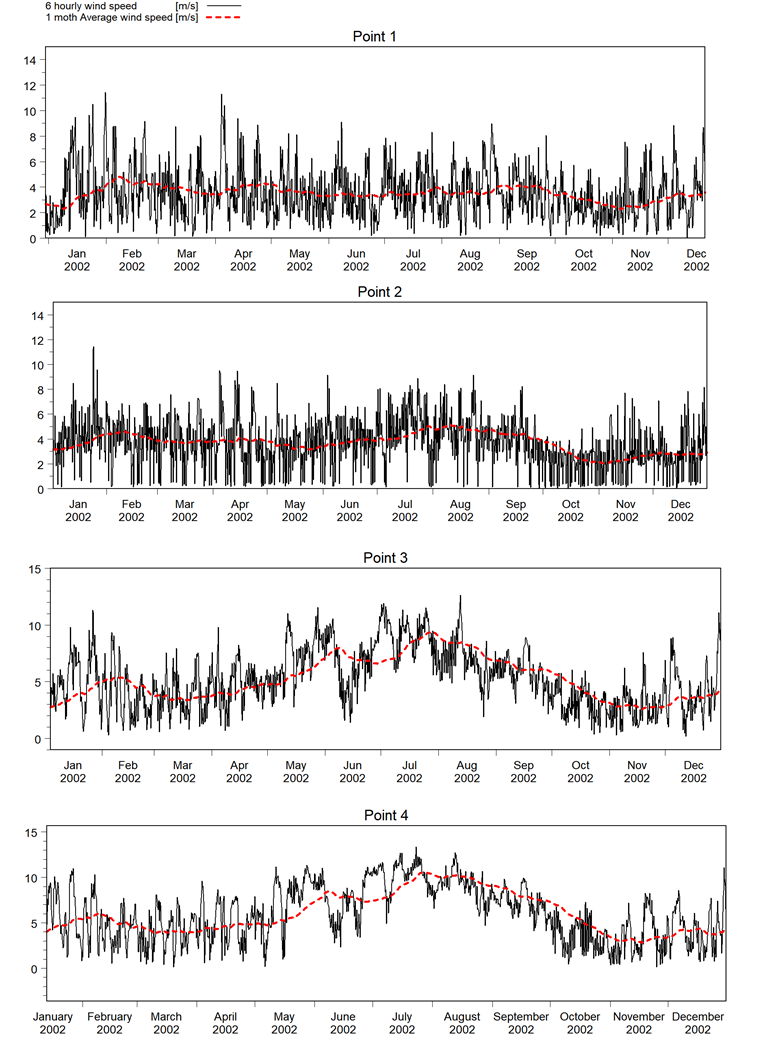 | Figure 5. Timeseries of simulated wind speed from four locations shown in Figure 1 in 2002 (data were obtained from ECMWF-ERA40 model) |
 | Figure 6. Time variations of wind vector at different points over the Gulf of Oman and the northern Arabian Sea (see Figure 1 for locations) during January 2002 |
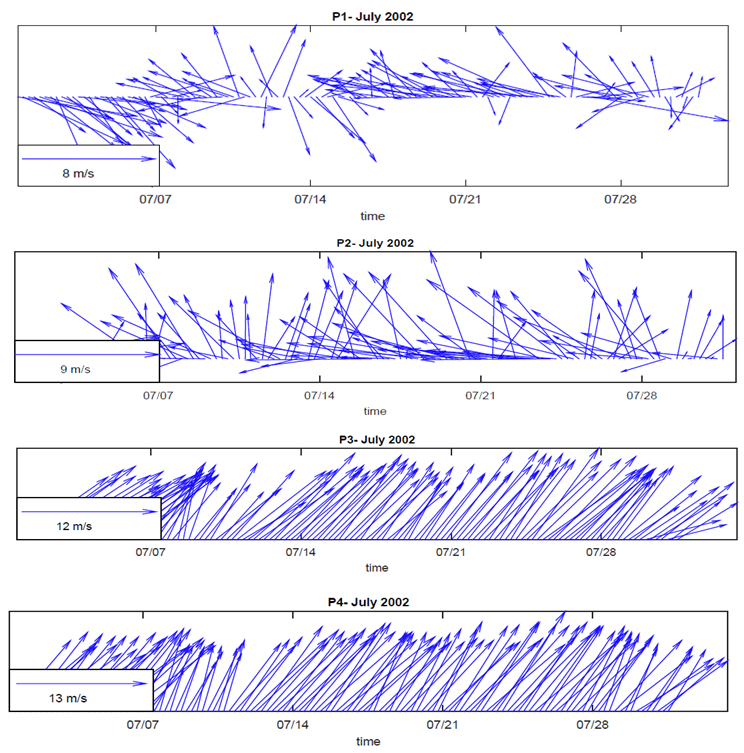 | Figure 7. Time variations of wind vector at different points over the Gulf of Oman and the northern Arabian Sea (see Figure 1 for locations) during July 2002 |
 | Figure 8. Wind roses at the location of P1-P4 based on 12-years data from ECMWF-ERA40 |
5. Summary and Conclusions
- In this paper wind climatology over the Gulf of Oman and the northern Arabian Sea was investigated and summarized by examining modeling data of surface atmospheric pressure and wind velocity components. Former studies provided different seasonal patterns for the wind regime over this region, which is driven by shifting of high and low pressure systems over the ocean and landmass. During fall-winter time period (November-April) contrasting latent heat of water and land produces a high pressure system over the continental Asia and a low pressure system over the Arabian Sea and the northern Indian Ocean. This generates north to south air flow which is associated with northeasterly winds of the winter monsoon. From July to the end of September persistent and intense southwesterly wind are predominate over the Arabian Sea and eastern parts of the Gulf of Oman. During this season locations for centers of high and low pressure systems over land and ocean are reversed so that high pressure system moves over the ocean. This intense and persistent wind substantially contributes to the regional circulation, wave dynamics, and redistribution of biogeochemical substances over the Arabian Sea and the Gulf of Oman. Coastal and offshore upwelling induced by this wind, forms one of the most productive oceanic areas along and off the coasts of Oman in the northern Arabian Sea. Waves that are generated over the Arabian Sea by summer monsoon highly contribute to the wave dynamics of the northern Gulf of Oman by forming bimodal frequency spectra over this region in conjunction with local waves. During the pre-monsoon (May and June) and post-monsoon (October), winds are not as persistent as summer and winter monsoons and significantly decrease in speed. As time series of wind speed and direction at different locations demonstrated, summer monsoon has the minimum effect on wind regime along in the west of the Gulf of Oman and in the western part, a relatively weak effect is detected in comparison to locations in the northern Arabian Sea. Long-term wind roses show dominant wind directions of westerly-northwesterly and southeasterly for locations in the Gulf of Oman and the northern Arabian Sea respectively.
 Abstract
Abstract Reference
Reference Full-Text PDF
Full-Text PDF Full-text HTML
Full-text HTML